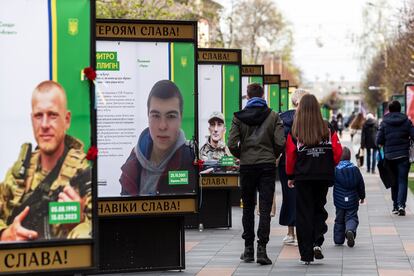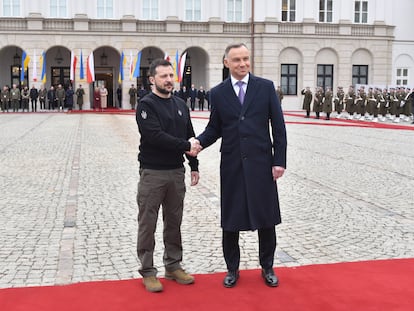War in Ukraine: Escalation of fighting worsens abuses against prisoners of war
A recent UN report claims that the alleged beheading of a Ukrainian soldier is just one example of how POWs, from both sides of the conflict, are systematically abused

A video that claims to show a Ukrainian soldier being beheaded by Russian troops caused outrage in the international community last week, with even Kremlin spokesman Dmitry Peskov describing the footage as “horrible.” The Russian Prosecutor General’s Office announced that it would open an investigation to clarify what happened, according to a recent United Nations report on crimes against prisoners of war in Ukraine. Such a move from Moscow is unprecedented, but what is not unusual, according to the U.N. report, human rights organizations and witnesses who spoke to EL PAÍS, are the abuses against prisoners of war (POWs), from both sides of the conflict.
The scale of Russia’s crimes against the civilian population in Ukraine exceeds all other human rights abuses in the war. “After 13 months of the Russian Federation’s war against Ukraine, severe violations of human rights and international humanitarian law have become shockingly routine,” Volker Türk, the U.N. High Commissioner for Human Rights, said on March 31. “Our staff have verified more than 8,400 civilian deaths, and over 14,000 civilians wounded, since 24 February 2022. These figures are just the tip of the iceberg. Most of the casualties resulted from the Russian forces’ use of wide-impact explosive weaponry in residential neighborhoods. In occupied areas of Ukraine, we have documented numerous summary executions and targeted attacks on civilians.”
But less attention has been paid to war crimes against soldiers who have surrendered at the front. According to a report by the U.N. Mission for the Monitoring of Human Rights in Ukraine (HRMMU), both the Ukrainian and Russian armies systematically violate international law and the Geneva Convention with respect to the treatment of prisoners. The findings of the report, which are based on a 13-month investigation, are shocking for both sides.
The video of the alleged beheading came to light as another recording showing the mutilated corpses of alleged Ukrainian soldiers was found. ”Regrettably, this is not an isolated incident,” the HRMMU said in a statement. In March, a video of an unarmed Ukrainian soldier being machine-gunned to death by Russian troops sparked outrage in Ukraine and across Europe. In February, another recording claiming to show three Russian servicemen shot in the head by Ukrainian fighters was also released. The HRMMU report has authenticated some of these videos, which are often posted on social media by the soldiers who filmed them.
Ukrainian presidential adviser Daria Zarivna said Wednesday that Russian soldiers were sharing the videos as part of a psychological operation “aimed at intimidation.” However, according to the HRMMU and Human Rights Watch (HRW), this psychological weapon is also being used by the Ukrainian side. In its report on the first year of the invasion, HRW said that both armies publicly taunted prisoners of war, in contravention of the Geneva Convention.
The U.N. report lists several examples of this. On the Russian side, the HRMMU described an extreme case in which two Ukrainian prisoners were filmed as they were forced to drag themselves half a kilometer with a broken leg. On the Ukrainian side, HRW notes that there have been several cases of Ukrainian forces filming Russian prisoners in deplorable conditions to publicly humiliate them. Last Saturday, a video on Telegram showed Ukrainian soldiers laughing at the wounded state of three Russian soldiers, who had surrendered in a forest.
The HRW report also confirmed a case of torture that was filmed last March in Mala Rohan, a town in Kharkiv province. The video shows three Russian soldiers — captured after the town was liberated by Ukrainian forces — being shot in the leg by Ukrainian troops. EL PAÍS visited Mala Rohan in July and spoke to two women who said that Russia’s occupying troops had raped Ukrainian women. Locals interviewed for the HRW report suggested that the Ukrainian soldiers may have shot the Russian POWs out of revenge. The U.N. report includes several examples of torture against Russian prisoners in retaliation for crimes committed against the civilian population. In June, a Ukrainian officer stabbed three Russian soldiers who had surrendered in Sloviansk; another was suffocated until he lost consciousness and the next day his arm was cut.
Torture is common, although it is much more widespread on the Russian side. More than 90% of imprisoned Ukrainian soldiers interviewed by the HRMMU said they had been tortured and ill-treated, compared to 49% of Russian prisoners. A fighter from the Ukrainian International Legion told EL PAÍS last week that Ukrainian soldiers are terrified of being captured by Russian forces. In February, an official from the Ukrainian intelligence services told this newspaper that on the front in the eastern province of Donetsk neither Russia nor Ukraine “prioritizes” taking soldiers prisoner, explaining that only officers are targeted because they have more information.
In both armies the most common form of torture is beatings, although the Russians use other forms of mistreatment more extensively, such as electrocution and sexual abuse. The HRMMU reports that both sides have used old TA-57 military telephones to give POWs electric shocks. On the Ukrainian side, no cases of sexual assaults have been identified, while on the Russian side, there is even evidence that a prisoner was castrated.
Another key difference, according to the HRMMU, is that while Ukrainian authorities “actively” collaborated to help the investigation, Russian authorities restricted access to detention centers. The Red Cross has also denounced the challenges involves with visiting Ukrainian POWs: Moscow has only given the organization occasional access to Donetsk and not since December, 10 months after the start of the invasion.
The U.N. also reports that Russian POWs have better living conditions than Ukrainian prisoners, and unlike Ukrainian POWs, they are allowed to contact their families. What’s more, the Ukrainian prosecutor’s office has opened five investigations into the summary execution of 22 Russian prisoners — a move Russia had not made until the alleged beheading went public last week. But the HRMMU report regrets that Ukrainian prosecutors have made no progress in their probe.
Russia’s lack of collaboration was clearly evident last July when at least 50 Ukrainian prisoners of war died in a building in Olenivka, a Russian-occupied village in Donetsk. They were killed after Ukrainian forces bombed the building. A few weeks after the incident, the U.N. and Turkey announced that Russia and Ukraine had reached an agreement to clarify what happened. But in the end, Russia backed out. The HRMMU report suggests that Russian forces most likely placed Grad missile batteries near the building, so that Ukraine would bombard the site and unknowingly kill dozens of their compatriots.
Sign up for our weekly newsletter to get more English-language news coverage from EL PAÍS USA Edition
Tu suscripción se está usando en otro dispositivo
¿Quieres añadir otro usuario a tu suscripción?
Si continúas leyendo en este dispositivo, no se podrá leer en el otro.
FlechaTu suscripción se está usando en otro dispositivo y solo puedes acceder a EL PAÍS desde un dispositivo a la vez.
Si quieres compartir tu cuenta, cambia tu suscripción a la modalidad Premium, así podrás añadir otro usuario. Cada uno accederá con su propia cuenta de email, lo que os permitirá personalizar vuestra experiencia en EL PAÍS.
¿Tienes una suscripción de empresa? Accede aquí para contratar más cuentas.
En el caso de no saber quién está usando tu cuenta, te recomendamos cambiar tu contraseña aquí.
Si decides continuar compartiendo tu cuenta, este mensaje se mostrará en tu dispositivo y en el de la otra persona que está usando tu cuenta de forma indefinida, afectando a tu experiencia de lectura. Puedes consultar aquí los términos y condiciones de la suscripción digital.
More information
Archived In
Últimas noticias
There is as much life left to discover on planet Earth as that which is already known
Dozens presumed dead, around 100 injured in fire at Swiss Alps bar during New Year’s celebration
Is porn for women different from conventional porn? We spoke to those who make it
Cartagena de Indias is sinking: What can the city do to mitigate it?
Most viewed
- Reinhard Genzel, Nobel laureate in physics: ‘One-minute videos will never give you the truth’
- David King, chemist: ‘There are scientists studying how to cool the planet; nobody should stop these experiments from happening’
- Oona Chaplin: ‘I told James Cameron that I was living in a treehouse and starting a permaculture project with a friend’
- Sinaloa Cartel war is taking its toll on Los Chapitos
- The Interoceanic Train, the Mexican alternative to the Panama Canal











































